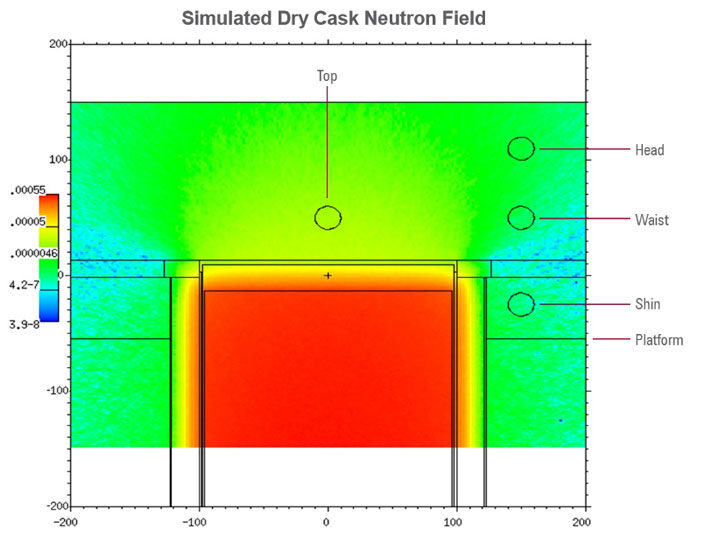Dry Cask processing operations present a number of complex radiological challenges. The presence of both neutron and gamma radiation coupled with the varying amounts of shielding already provided by the cask and canister make it difficult to know where to put shielding and what type shielding to use. Additionally, shielding limitations often exist in the form of max weight and temperature. To help solve these challenges NPO employs the expertise of our affiliate, PG Research Foundation, and MCNP code. MCNP (Monte Carlo N – Particle) was developed by Los Alamos National Laboratory to simulate nuclear processes for applications such as criticality safety, accelerator target design, reactor design, etc. Within the software 3D shapes and radiation spectrums can be created to produce numerous outputs including color plots of attenuation and dose (mRem/hr). In the case of Dry Cask shielding, the canister, transfer cask, and work platform are modeled in a 3D environment and a combination of the Watt Fission Spectrum and a gamma profile is used to simulate aged spent fuel. From here, various combinations of shielding are applied until the optimal solution is revealed. This capability is a tremendous asset for comprehensive shielding design. Attenuation estimates, particularly with complex sources and geometries, are much more accurate as they account for all important attenuation interactions including scattering and secondary radiation production. Additionally, shielding can be increased where it is needed most and decreased, or eliminated, where it is not as beneficial. Dry Cask is not the only application for MCNP. Currently NPO is also running a simulation on a filter shielding cabinet, any complex shielding problem can be analyzed.
Neutron Dose – mRem/hr (μSv/hr)
| Unshielded | w/Shield Bell+Floor | w/Shield Bell+Floor+Lid | |
| Shin | 280 (2,800) | 53 (530) | 50 (500) |
| Waist | 392 (3,920) | 230 (2,300) | 17 (170) |
| Head | 566 (5,660) | 484 (4,840) | 29 (290) |
| Top | 3,533 (35,330) | 3,533 (35,330) | 221 (2,210) |
